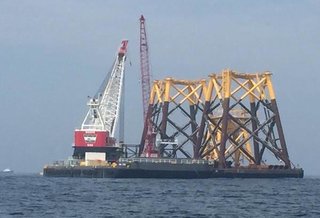Contractors for Deepwater Wind are installing foundations for the Providence, R.I., company’s wind energy demonstration project near Block Island, marking the start of the first ocean wind energy project in U.S. waters.
“Steel in the water today,” Deepwater CEO Jeff Grybowski reported Sunday on the social network Twitter, a few days after sea conditions forced postponing of the first emplacement on the sea floor about three miles off the island.On Monday, U.S. Interior Secretary Sally Jewell, Rhode Island Gov. Gina Raimondo and others toured the site by boat.
“As the nation’s pioneering offshore commercial wind farm, the lessons learned from the Block Island project about facility design, fabrication and installation will inform future projects to be developed on the Outer Continental Shelf,” said Abigail Ross Hopper, director of the Department of Interior’s Bureau of Ocean Energy Management (BOEM).
Built by Gulf Island Fabrication at its Houma, La., facility, with additional subcontracting work by Specialty Diving Services of North Kingstown, R.I., the five 1,500-ton steel structures are being erected in state waters.
Gulf Island builds components for fixed and floating drilling and production platforms in the Gulf of Mexico, and built the steel deepwater structures of sheet jackets, decks and piles. Deepwater Wind officials say the installations are designed to withstand forces in a so-called 1,000-year storm, an event with only a 0.1% chance of happening in a given year.
The 433’x128’ Bold Tern self-propelled jackup crane vessel operated by Fred. Olsen Windcarrier is the main work platform for installation. Norway-based Fred. Olsen & Co. became involved with offshore wind energy in Scandinavia in the 1990s, and installed the first Alstom Haliade 150 demonstrator turbine off Belgium in fall 2013. The Block Island turbines will be among the tallest in the world at 589 feet.
Also on the Block Island job are Seattle-based Manson Construction and Weeks Marine from New Jersey, employing the Weeks 533 revolving crane to drive pilings and set foundation supports. With its 500-ton capacity, the crane is known around New York Harbor for epic tasks like lifting a space shuttle and Concorde supersonic transport onto the USS Intrepid museum ship. The smaller Weeks 526 and Weeks 571 are also in the construction fleet that shuttles between the Block Island site and the project base at Quonset Point up Narragansett Bay.
Meanwhile, Blount Boats, Warren, R.I., has begun building the first crewboat for the offshore U.S. wind industry.
The 69'×24'×8'10"all-aluminum crew transfer vessel (CTV) is being built for Rhode Island Fast Ferry to serve theDeepwater Wind project. It is being built under license from South Boats IOW, on the Isle of Wightin the United Kingdom, a major supplier to the European wind industry withabout 85 CTVs delivered.
In federal waters, the BOEM has so far awarded nine commercial wind energy leases. Two non-competitive leases are for the stalled Cape Wind project off Massachusetts and a Delaware project. Seven competitive lease sales off southern New England, Maryland and Virginia granted would-be wind power operators access to 700,000 acres for $14.5 million. BOEM officials expect to hold the next auction for wind leases off New Jersey later this year.





